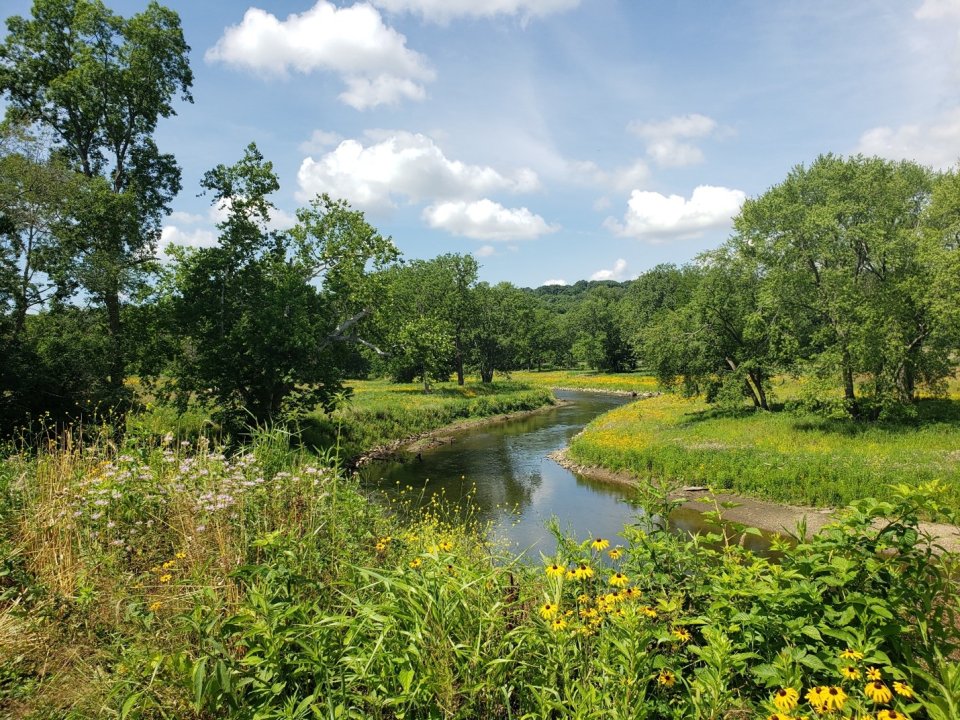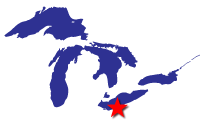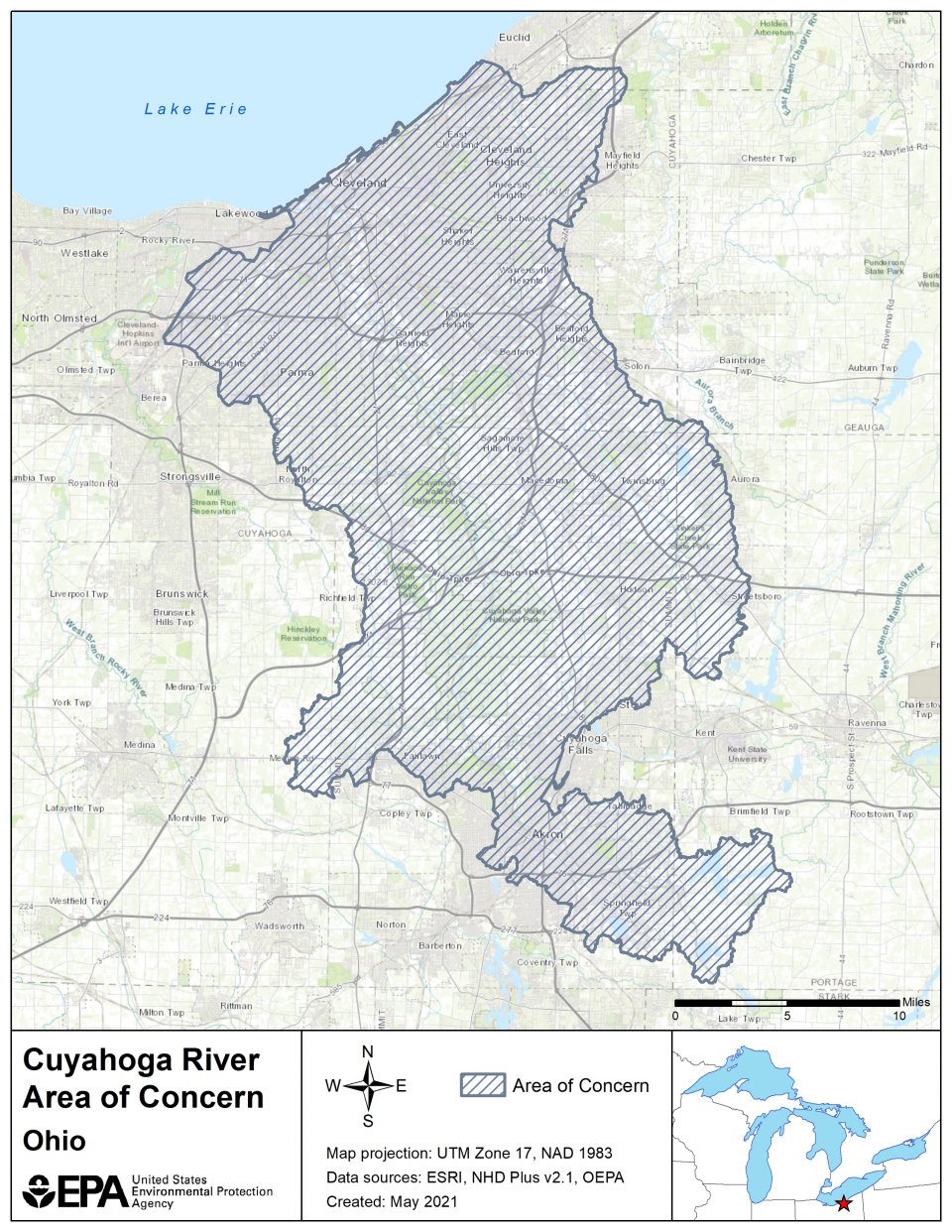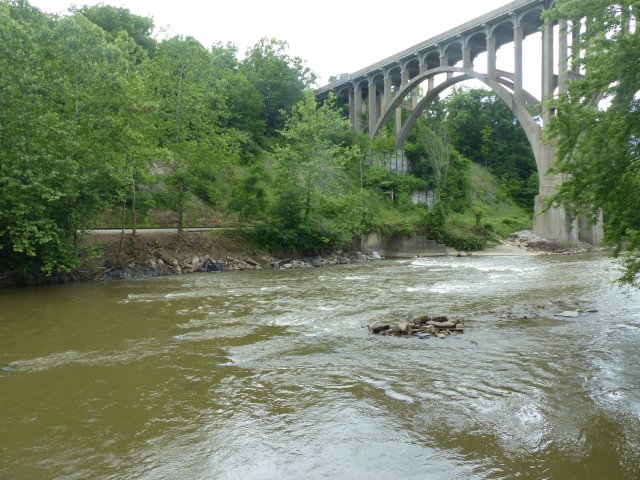Cuyahoga River AOC
Suse La Gory
(lagory.susanna@epa.gov)
312-886-5253
Latest News
Overview
The Cuyahoga River is in northeastern Ohio and flows through Cleveland and into Lake Erie. The river drains over 800 square miles. The Cuyahoga River area became an Area of Concern in 1987 under the Great Lakes Water Quality Agreement.
The Cuyahoga River watershed is degraded due to sediment and streambank erosion, water quality impacts from municipal and agricultural discharges, and historic contamination from urban and industrial sources. While urban stormwater runoff, combined sewer overflows and wastewater treatment plant bypasses are still in the process of being addressed, the overall water quality is starting to improve in the AOC.
Work restoring the AOC continues, with a key focus on restoring habitat for fish and wildlife throughout the watershed. Habitat for fish and wildlife in the Area of Concern is impacted due to a loss of high-quality habitat, mainly from floodplains and riparian wetlands. Restoration efforts also target the removal of dams that inhibit fish passage from Lake Erie into the Cuyahoga River.
The last element of restoring habitat is through stream restoration. Stream restoration increases habitat diversity (riffles, pools, structure), while shoreline stabilization work reduces erosion and sedimentation. Collectively these many restoration efforts will create large-scale improvements to the overall fish and wildlife habitat in the AOC.
Cleanup and restoration in the Cuyahoga River AOC are important elements of protecting and enhancing habitat for fish and wildlife. Restoration of the river system is also important for the people who live in the many cities within its watershed. Restoring the river will help improve and enhance recreational opportunities and support regional communities who can benefit from having a cleaner river system and Great Lakes ecosystem.
Beneficial Use Impairments
An interim success of remediation and restoration work is removing BUIs. BUIs are designations given by the International Joint Commission representing different types of significant environmental degradation. As cleanup work is completed and monitoring demonstrates sufficient environmental health improvements, BUIs can be removed. The list below shows which BUIs have been removed and which remain. Once all BUIs are removed, the process of delisting the AOC can begin.
- Restrictions on Fish and Wildlife Consumption - Removed January 2019
- Degradation of Fish and Wildlife Populations
- Fish Tumors or Other Deformities - Removed August 2023
- Degradation of Benthos
- Restrictions on Navigational Dredging
- Eutrophication or Undesirable Algae - Removed April 2021
- Beach Closings - Removed September 2024
- Degradation of Aesthetics - Removed November 2017
- Loss of Fish Habitat
- General information about BUIs: Beneficial Use Impairments for the Great Lakes AOCs
Remediation and Restoration Work
To help remove impairments in the Cuyahoga River, EPA and state and local stakeholders must complete Management Actions, or on-the-ground projects deemed necessary to fully restore the AOC.
GLRI-funded projects will help restore habitat in the Cuyahoga River, Little Cuyahoga River, West Creek, and the surrounding wetlands and floodplains. Habitat projects include restoring oxbow wetlands, stabilizing and restoring eroded shorelines, installing and restoring shored floodplain, and removing low-head dams. Habitat projects like these help regulate the negative effects of high-water events by reducing the erosive capacity of the river and allowing high water to instead flow through new floodplains. Other targets in the AOC include increasing fish passage and recruitment by stabilizing streambanks in the river and creating ecologically beneficial aquatic habitat. In addition to improving habitat for fish and wildlife populations, the river will be more accessible to water-based recreation once the restoration work is completed.
Under the Great Lakes Legacy Act, two major contaminated sediment projects have been identified in the Cuyahoga River AOC. Both projects are currently in the design phase and are cost-shared between EPA and state and local partners. The Cuyahoga River Old Channel project (CROC) is located at the terminus of the old shipping channel near Lake Erie, and the Cuyahoga River Gorge project is located at the upper end of the AOC between the Cities of Akron and Cuyahoga Falls, OH. These projects will remediate sediment contaminated with PCBs, PAHs, heavy metals, pesticides, and oil and grease. The Cuyahoga River Gorge GLLA project addresses contaminated sediment behind the Gorge Dam. Following completion of the sediment remediation work, the dam itself will be removed in a subsequent GLRI funded project. Removing the Gorge Dam will ultimately restore historic free-flowing conditions to over 1.5 miles of the Cuyahoga River corridor that are currently restrained behind the dam. This will improve fish and wildlife habitat while enhancing aesthetic and recreational opportunities within the AOC. It is anticipated that these projects could begin as early as 2024.
- Documents on Restoring Cuyahoga River AOC
- Remediation and Restoration Projects for Cuyahoga River AOC
Highlighted Restoration Projects
Remediation Project Highlight: Cuyahoga-Gorge Dam Sediment Remediation
For details about the Cuyahoga Gorge Dam Sediment Remediation, visit the project webpage: Cuyahoga Gorge Dam Great Lakes Legacy Act Cleanup
Restoration Project Highlight: Brecksville Canal Diversion Dam Removal
The Brecksville Dam, located in the Cuyahoga Valley National Park and the Cuyahoga River AOC, has been removed in collaboration with local, state, and federal partners. The Brecksville Dam is also known as the Station Road Dam, Canal Diversion Dam, and State Route 82 Dam.
According to the National Park Service (NPS), the wooden Pinery Dam was built in 1827 to divert water from the Cuyahoga River into the Ohio & Erie Canal. The concrete Brecksville Dam was built over the Pinery Dam in the 1950s to give water to industry in the area. Since dams impede fish migration, change water temperatures, and increase turbidity and sedimentation, both dams were removed in 2020 to improve the health of the river. Now that the dam has been removed, the Cuyahoga River is flowing freely, improving fish passage, reducing sedimentation, and enhancing paddling and recreation on this part of the Cuyahoga River.
In late May of 2020, the dam was “notched” – the first step in removing the dam. Notching allows water levels to be lowered in a controlled manner. After water levels were lowered the deconstruction process took place. This controlled deconstruction allowed the historic Pinery Dam to be uncovered and documented for historical records and cultural resource purposes. Both dams were removed in July 2020. Next steps include creating modifications to the pumping system that will maintain water in the historic Ohio & Erie Canal. A new pumping system was installed in spring 2022 that will maintain water in the historic Ohio & Erie Canal.
Local stakeholders, along with State and Federal agencies have made removing this dam a priority. The Great Lakes Restoration Initiative (GLRI) funded $800,000 of the project, and local and State sources also contributed $900,000. Now that the dam is removed, NPS and local groups will work to maintain water levels in the Ohio & Erie Canal. This way, water quality in the Cuyahoga can be improved while also preserving historic features in the Cuyahoga Valley National Park.
Targeted BUIs:
- Degradation of Fish & Wildlife Populations
- Degradation of Benthos
- Loss of Fish & Wildlife Habitat
Highlighted Restoration Project: Cascade Valley View Habitat Restoration
Fish and wildlife will have access to restored habitat along the middle Cuyahoga River at Cascade Valley View, thanks to a partnership project between NOAA, the Great Lakes Commission (GLC), Summit Metro Parks, and GLRI. This project has nearly doubled the river’s capacity in the project area through floodplain restoration and removal of berms. The project installed natural stream features like rock-riffle structures, root-wads, and more natural bank modifications. Trees were planted on 50 acres of improved floodplain and along nearly a mile of the river.
With the improvements here and the removal of the Gorge Dam, this section of the Cuyahoga River will once again be open to migratory Lake Erie fish, including steelhead, muskellunge, and walleye. Lake Sturgeon, an endangered fish in the state of Ohio, will once again have access to clean gravel substrates in these historical spawning sites and locations proposed for in-stream restoration. This project will not only benefit the environment and the fish and wildlife who make their habitat in Cascade Valley View, but it will also benefit the local economy and community with improved sport fishing, recreation, and shoreline safety. As conditions continue to improve and dams are removed, migratory fish including walleye, muskellunge, and steelhead will again have access to this part of the river.
This project was made possible through a strong partnership between federal, state, and local agencies. Project funding comes from NOAA through a Regional Partnership with GLC. Approximately $3.1 million was provided through GLRI, and the project is managed locally by Summit Metro Parks.
- Loss of Fish and Wildlife Habitat
- Degradation of Fish and Wildlife Populations
- Degradation of Benthos

Partners
- National Park Service: Cuyahoga Valley National Park
- U.S. Fish & Wildlife Service
- Cuyahoga River AOC Advisory Committee
- Ohio EPA Lake Erie Programs
- Ohio EPA Cuyahoga River Watershed
- Pond Brook Watershed Initiative
- National Oceanic and Atmospheric Administration
- U.S. Army Corps of Engineers
- City of Akron
- City of Cuyahoga Falls
- Cleveland Metroparks
- Cuyahoga County Department of Public Works
- Cuyahoga County Soil & Water Conservation District
- Northeast Ohio Regional Sewer District
- Cuyahoga County Department of Public Works
- Northeast Ohio Four County Regional Planning and Development Organization (NEFCO)
- Ohio Department of Transportation (ODOT)
- Ohio Department of Natural Resources
- Ohio EPA
- Ohio Lake Erie Commission
- Ohio Sea Grant
- Summit MetroParks



